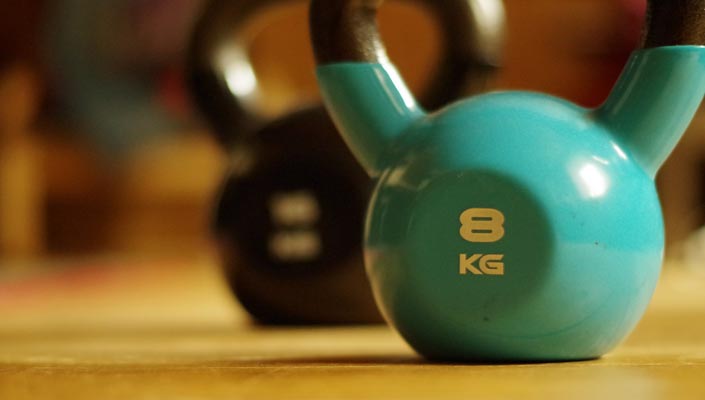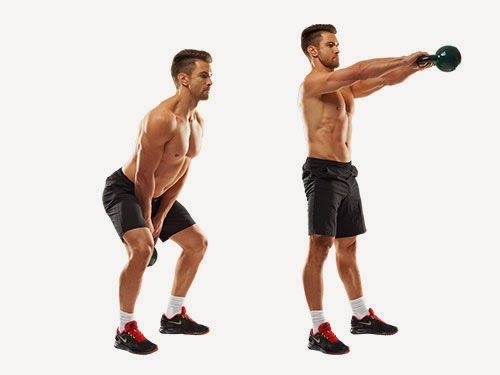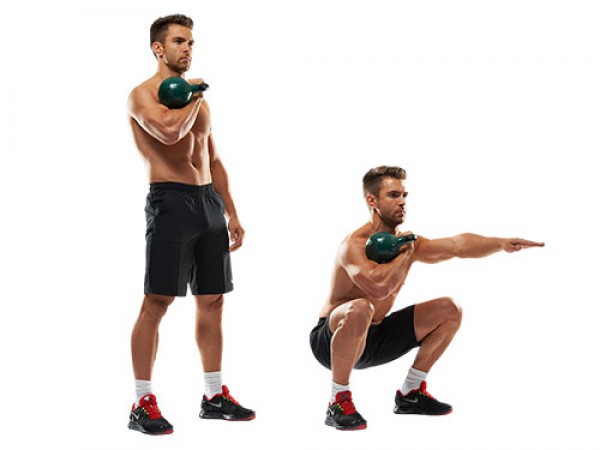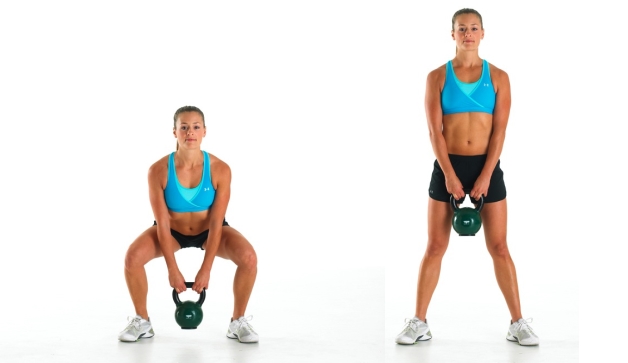
Our other "5 Minute Fixes" have involved using either your body weight or some very basic equipment such as your bike or a foam roller. We continue this theme of simplicity today by looking at a series of exercises using the most basic piece of gym equipment available, the kettlebell. With this one piece of equipment and a few standard exercises you can gain the following benefits:
- 2 in 1: Combine weight & cardio workouts in one. Kettlebell workouts get the heart rate soaring and work on muscle development.
- Time saver: Short but intense sessions, 2 or 3 times per week, are sufficient for fitness gains.
- Target your hamstrings and glutes (known as your posterior chain), key muscles for improving your cycling performance.
- Strengthen your core: Kettlebell exercises are generally great for strengthening your core and back. A strong core helps cycling performance by providing a solid platform for your legs to drive power from, good posture both on and off the bike and helps reduce or recover from back injuries.
- Space saving: one piece of weight equipment and you have all the workout gear you need.
What Size Kettlebell Do I Need?
As a bit of a guideline (obviously it varies enormously based on your size and strength), women should probably start with a 6-8kg (15-18lb) kettlebell, and men with a 12-16kg (26-35lb) kettlebell.
The Exercises And How To Do Them
The Swing

This exercise is the cornerstone of kettlebell training and for good reason. It will build core and hip strength, increase power, fight arm pump, and take your cardio capacity to another level. It also reinforces good body position on the bike and teaches us how to effectively use the hips to absorb impacts and power lower body movement. It is as close to doing a hard, technical ride as you can get without actually throwing your leg over a bike.
The first exercise to look at is the two-hand kettlebell swing and how to adapt it to cycling:
- Begin in a standing position with feet hip-shoulder width apart with the kettlebell held by both hands in front of the hips.
- Brace the core by squeezing navel to spine. This stabilizes and helps protect the back. Push hips backwards, so that the kettlebell swings between the legs.
- When the kettlebell reaches the bottom of its swing, extend the hips and knees strongly so that sufficient force is created to elevate the kettlebell to shoulder height.
- As the kettlebell rises the arms should be relaxed and the shoulders drawn back. The movement should use the momentum of the swing to elevate the kettlebell to shoulder height with the arms horizontal, rather than trying to lift the kettlebell out in front.
- Let the kettlebell drop between the legs again and repeat.
If this is a new exercise then keep the number of repetitions and the load low. This exercise has provided a dynamic load in knee extension, hip extension, stabilization of the core, and shoulder retraction. This exercise can be progressed by increasing the load.
The next step to make this exercise more functional in respect to cycling is to consider how the upper body is used. If you have been watching footage from the Tour de France you've probably noticed that as the riders approach the finish line during a sprint you can see that each arm pulls on the handlebar on the same side as the leading leg pushing the pedal down, which usually causes the bike to tilt from side to side.
This movement can be easily replicated using the kettlebell by using a one-handed swing. The routine is exactly the same as the two-handed swing, but the kettlebell is just held in one hand. Be extra careful to ensure that the kettlebell swings between the legs and not into the legs. As we are only using one arm, it may be a good idea to reduce the size of the weight for this compared to the two-handed swing.
This exercise extends the knee and hips as before. The shoulder is retracted (pulled back and in) in the upswing as before. This time, however, an unequal load and slight twist has been presented on the upper body to simulate pulling on each side of the handlebar.
Squats

If you've ever done traditional squats in the gym, you'll notice immediately that you won't need anywhere near the same amount of weight when squatting with kettlebells, as the increased instability of the kettlebells makes up for the lack of load. But don't worry, you'll still be able to blast that lower body!
- Pick up the kettlebell into the "Rack" position, with the kettlebell at shoulder height resting on your forearms, biceps, and shoulder with a neutral wrist position and your elbow tucked in close to your ribs.
- Set Your Feet - Keep your feet shoulder width apart, and toes straight ahead or turned out five to ten degrees.
- Sit Down - As opposed to sitting back, which you would do in other squat variations, you're going to sit straight down, making sure you stay in your heels and keep your hips underneath you the whole time. It's important to mention that doesn't mean let your toes come up off the ground. We want those down, too. It just means to feel your heels in the ground as you squat. Also, it may help if you think about using your hamstrings to pull yourself straight down.
- Breathe - Now that you're in the bottom position, stay tight. And don't be in a rush to leave. Take a big breath in and on your exhale you're going to start standing up.
- Press the Ground Away - On your exhale, picture in your mind that you're pressing the ground away through your heels to stand up. Be sure to keep your hips stable and strong, and focus on keeping them underneath you.
- Finish - Continue pressing the ground away until you reach the top of the lift and finish in the same neutral position you started in.
A squat, in its truest essence, is a straight-up-and-down movement. Sitting your butt straight down, staying in your heels, and coming straight back up. The placement of the kettlebells and the increased recruitment of your core makes this one of the best variations to work on this up-and-down pattern.
Another great variation is the Goblet Squat, which is awesome for building the lower body strength needed to grind through a higher gear on the trail or back roads, and for building core strength. Traditional barbell squats are easy to do wrong and injure yourself, but the Goblet Squat forces you to do this important movement correctly and, as an added bonus, builds a strong upper back to combat the forward sloping shoulder posture so common among riders. The principle is the same as the traditional kettlebell squat, but instead of holding the kettlebell in the "Rack" position, it is held by the handle with both hands against your upper chest, almost tucked under your chin. By positioning the weight in front of you, it enables you to counter-balance by leaning back slightly and really improves your squat technique.
The Deadlift

If the Swing is the cornerstone of kettlebell movement, the Deadlift is the foundation, adding strength and flexibility to your hips, hamstrings, glutes, and back.
- Stand with your feet shoulder-width apart with the kettlebell between your legs and the handle in line with the bony part of your ankles. Bend from the hips and grab the kettlebell with both hands. Before you lift, your shins should be vertical, your back should be almost parallel with the ground, and your lower back should be flat.
- Squeeze the handle hard, pull your shoulders backward, and crush your armpits. Lift the kettlebell by pushing through the ground, not by pulling up. Stand tall and squeeze your glutes at the top. On the way down, place the kettlebell at the same exact spot you lifted it from.
So there you have it - three or four basic exercises that can be completed in about five minutes per day (about one minute per exercise plus a very short rest between each one).
A final word of advice: start off being slow and conservative, and as your strength, muscular endurance and familiarity with the kettlebell improve you can go harder and longer.

RELATED ARTICLE:
The Foam Roller - Awesome recovery in 5 minutes a day
For fast recovery of stiff, sore muscles and a quick return to top riding condition, you need to get yourself on a roll!Without the benefit of a full-time masseur like the pro riders enjoy, the next best thing for cyclists is self-massage with a foam roller... READ MORE

RELATED ARTICLE:
Bodyweight Exercises - Unleash Your Inner Beast In 5 Minutes a Day!
For fast recovery of stiff, sore muscles and a quick return to top riding condition, you need to get yourself on a roll!Without the benefit of a full-time masseur like the pro riders enjoy, the next best thing for cyclists is self-massage with a foam roller... READ MORE


